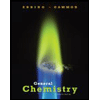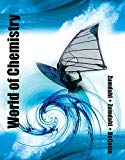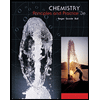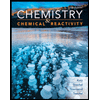
Mastering Chemistry with Pearson eText -- Standalone Access Card -- for Introductory Chemistry (6th Edition)
6th Edition
ISBN: 9780134565927
Author: Nivaldo J. Tro
Publisher: PEARSON
expand_more
expand_more
format_list_bulleted
Question
Chapter 5, Problem 68E
Interpretation Introduction
Interpretation:
The name of each polyatomic ion is to be determined.
Concept introduction:
Ions that are composed of a group of atoms with an overall charge are termed as polyatomic ions.
To name the ionic compounds that contains a polyatomic ion, use the name of the polyatomic ion.
Anions that are composed of oxygen are oxyanions.
If there are two ions in series, ion with more oxygen atoms ends with –ate and ion with fewer oxygen atoms ends with –ite.
If there are more than two ions in the series, use the prefixes hypo- which means ‘less than’ and per means ‘more than’.
Expert Solution & Answer
Want to see the full answer?
Check out a sample textbook solution
Students have asked these similar questions
Writing the rate law implied by a simple mechanism
To exit full screen, press and hold esc
Suppose the decomposition of dinitrogen monoxide proceeds by the following mechanism:
elementary reaction
step
rate constant
1
→
N2O(g) N2(g) + O(g)
k₁
→>>
N2(g) + O2(g)
k2
2 N2O(g) + O(g)
Suppose also k₁ «k2. That is, the first step is much slower than the second.
Write the balanced
chemical equation for the
overall chemical reaction:
Write the experimentally-
observable rate law for the
overall chemical reaction.
☐
rate
= k
Note: your answer should
not contain the
concentrations of any
intermediates.
Express the rate constant
k for the overall chemical
reaction in terms of K1, K2,
and (if necessary) the rate
constants k-1 and K-2 for
the reverse of the two
elementary reactions in
the mechanism.
k = |
Х
?
000
18
Ar
Using first- and second-order integrated rate laws
Consider this reaction:
CICH2CH2Cl (g) → CH2CHC1 (g) + HCl (g)
-
At a certain temperature it obeys this rate law.
S
rate = (0.0413 s¯¹) [CICH₂CH₂CI]
Suppose a vessel contains CICH2CH2Cl at a concentration of 0.150M. Calculate the concentration of CICH2CH2Cl in the vessel 39.0 seconds later. You may
assume no other reaction is important.
Round your answer to 2 significant digits.
Ом
x10
☑
?
00.
18
Ar
。
Hello I need homework help. Please focus on box 2 and 3, box 1 is correct.
Chapter 5 Solutions
Mastering Chemistry with Pearson eText -- Standalone Access Card -- for Introductory Chemistry (6th Edition)
Ch. 5 - Q1. Carbon tetrachloride has a chlorine - to-...Ch. 5 - Write a chemical formula for a compound that...Ch. 5 - Q3. How many oxygen atoms are in the chemical...Ch. 5 - Which element is a molecular element? a. Copper b....Ch. 5 - Q5. Which compound is ionic?
a.
b.
c.
d.
Ch. 5 - Write a formula for the compound that forms...Ch. 5 - Prob. 7SAQCh. 5 - Prob. 8SAQCh. 5 - Name the compound CrCl3 a. monochromium...Ch. 5 - Name the compound BaSO4 a. barium sulfate b....
Ch. 5 - Name the compound PF5. a. monophosphorus...Ch. 5 - Q12. What is the formula for manganese (III)...Ch. 5 - Q13. Name the acid (aq).
a. hydrogen phosphate
b....Ch. 5 - What is the formula for hydrobromic acid? a. HBr...Ch. 5 - Prob. 15SAQCh. 5 - 1. Do the properties of an element change when it...Ch. 5 - How might the world be different if elements did...Ch. 5 - What is the law of constant composition? Who...Ch. 5 - 4. What is a chemical formula? List some examples....Ch. 5 - 5. In a chemical formula, which element is listed...Ch. 5 - Prob. 6ECh. 5 - 7. Explain the difference between a molecular...Ch. 5 - What is a structural formula? What is the...Ch. 5 - What is the difference between a molecular element...Ch. 5 - Prob. 10ECh. 5 - What is the difference between a common name for a...Ch. 5 - List the metals that only one type of ion (that...Ch. 5 - Prob. 13ECh. 5 - Prob. 14ECh. 5 - Prob. 15ECh. 5 - Prob. 16ECh. 5 - Prob. 17ECh. 5 - Prob. 18ECh. 5 - What is the basic form for the named of molecular...Ch. 5 - How many atoms does each prefix specify? Mono-,...Ch. 5 - Prob. 21ECh. 5 - Prob. 22ECh. 5 - Prob. 23ECh. 5 - Prob. 24ECh. 5 - Two samples of sodium chloride are decomposed into...Ch. 5 - Two samples of carbon tetrachloride are decomposed...Ch. 5 - 27. Upon decomposition, one sample of magnesium...Ch. 5 - The mass ratio of sodium to fluorine in sodium...Ch. 5 - Use the law of constant composition to complete...Ch. 5 - Use the law of constant composition to complete...Ch. 5 - Prob. 31ECh. 5 - Prob. 32ECh. 5 - Prob. 33ECh. 5 - Prob. 34ECh. 5 - 35. How many oxygen atoms are in each chemical...Ch. 5 - 35. How many oxygen atoms are in each chemical...Ch. 5 - Determine the number of each type of atom in each...Ch. 5 - Determine the number of each type of atom in each...Ch. 5 - Prob. 39ECh. 5 - Complete the table. Formula Number of SO42units...Ch. 5 - 41. Give the empirical formula that corresponds to...Ch. 5 - 42. Give the empire formula that corresponds to...Ch. 5 - 43. Classify each element as atomic or...Ch. 5 - 44. Which elements have molecules as their basic...Ch. 5 - Classify each compound as ionic or molecular. a....Ch. 5 - Classify each compound as ionic or molecular. a....Ch. 5 - Match the substance on the left with the basic...Ch. 5 - Prob. 48ECh. 5 - What are the basic unitssingle atoms, molecules,...Ch. 5 - What are the basic unitssingle atoms molecules, or...Ch. 5 - 51. Classify each compound as ionic or molecular....Ch. 5 - 52. Classify each compound as ionic or molecular....Ch. 5 - 53. Write a formula for the ionic compound that...Ch. 5 - Write a formula for the ionic compound that forms...Ch. 5 - Prob. 55ECh. 5 - 56. Write a formula for the compound that forms...Ch. 5 - Prob. 57ECh. 5 - Prob. 58ECh. 5 - 59. Name each ionic compound. In each of these...Ch. 5 - 60 Name each ionic compound. In each of these...Ch. 5 - Prob. 61ECh. 5 - Prob. 62ECh. 5 - Determine whether the metal in each ionic compound...Ch. 5 - Prob. 64ECh. 5 - Prob. 65ECh. 5 - Prob. 66ECh. 5 - Prob. 67ECh. 5 - Prob. 68ECh. 5 - Prob. 69ECh. 5 - Prob. 70ECh. 5 - 71. Name each molecular compound.
a.
b.
c. NO
d....Ch. 5 - 72. Name each molecular compound.
a.
b.
C.
d....Ch. 5 - 73. Write a formula for each molecular compound...Ch. 5 - Write a formula for each molecular compound. a....Ch. 5 - Determine whether the name shown for each...Ch. 5 - Prob. 76ECh. 5 - Prob. 77ECh. 5 - Prob. 78ECh. 5 - Prob. 79ECh. 5 - 80. Name each acid (Hint: The names of the...Ch. 5 - 81. Write a formula for each acid.
a. phosphoric...Ch. 5 - Write a formula for each acid. a. hydrofluoric...Ch. 5 - 83. Calculate the formula mass for each...Ch. 5 - Calculate the formula mass for each compound. a....Ch. 5 - Prob. 85ECh. 5 - Prob. 86ECh. 5 - Prob. 87ECh. 5 - Prob. 88ECh. 5 - 89. How many chlorine atoms are in each set?
a....Ch. 5 - Prob. 90ECh. 5 - Prob. 91ECh. 5 - Prob. 92ECh. 5 - Prob. 93ECh. 5 - Prob. 94ECh. 5 - Prob. 95ECh. 5 - Prob. 96ECh. 5 - 97. For each compound, list the correct formula...Ch. 5 - For each compound, list the correct formula and...Ch. 5 - 99. Name each compound and calculate its formula...Ch. 5 - 100. Name each compound and calculate its formula...Ch. 5 - A compound contains only carbon and hydrogen and...Ch. 5 - Prob. 102ECh. 5 - 103. Carbon has two naturally occurring isotopes:...Ch. 5 - Nitrogen has two naturally occurring isotopes:...Ch. 5 - Prob. 105ECh. 5 - Molecules can be as small as two atoms or as large...Ch. 5 - Prob. 107ECh. 5 - Prob. 108QGWCh. 5 - Prob. 109QGWCh. 5 - Prob. 110QGWCh. 5 - Calculate the formula mass for each compound in...Ch. 5 - 112. Climate scientists have become increasingly...
Knowledge Booster
Similar questions
- Using first- and second-order integrated rate laws At a certain temperature the rate of this reaction is second order in H3PO4 with a rate constant of 0.709M¯¯ 2H3PO4 (aq) → P₂O5(aq)+3H₂O(aq) -1 -1 ·S Round your answer to 2 significant digits. Suppose a vessel contains H3PO4 at a concentration of 0.880M. Calculate how long it takes for the concentration of H3PO4 to decrease to 0.141M. You may assume no other reaction is important. x10 ? 00. 18 무arrow_forwardNaming coordination compounds Name these coordination compounds. formula [FeCl2 (CO)4] Cl Na₂ [MnBr, (NH)₂] 4 [GCL (H,0),]C name Х 000 18 Ararrow_forwardWhy does this phenomenon of optically active occur? As you observed in the lab, why do the various compounds alter the results? What causes the differences? How do you know these molecules are all optically active, if they are? How does the concentration, purity, and identity of the substance effect the results? What must occur for the phenomenon to be observed?arrow_forward
- Deducing a rate law from the change in concentration over time A chemistry graduate student is studying the rate of this reaction: 2NH3 (g) → N2 (g) +3H₂ (g) She fills a reaction vessel with NH3 and measures its concentration as the reaction proceeds: ? time (minutes) [NH3] 0 1.00M 1.0 0.571M 2.0 0.400 M 3.0 0.307M 4.0 0.250M Use this data to answer the following questions. Write the rate law for this reaction. rate k ☐ x10 Calculate the value of the rate constant k. k = ☐ Round your answer to 2 significant digits. Also be sure your answer has the correct unit symbol. G 000 18 Ar 。arrow_forwardWriting the rate law implied by a simple mechanism Suppose the formation of dinitrogen pentoxide proceeds by the following mechanism: step elementary reaction - 1 NO2(g) + O2(g) → NO(g) + O2(g) 2 NO3(g) + NO2(g) → N₂O(g) rate constant k₁ k₂ Suppose also k₁ «k2. That is, the first step is much slower than the second. Write the balanced chemical equation for the overall chemical reaction: Write the experimentally- observable rate law for the overall chemical reaction. Note: your answer should not contain the concentrations of any intermediates. ☐ rate = ☐ Express the rate constant k for the overall chemical reaction in terms of K1, K2, and (if necessary) the rate constants k-1 and K-2 for the reverse of the two elementary reactions in the mechanism. k = ☐ Х 5 olo 18 Ararrow_forwardpls help asap on all.arrow_forward
- pls help asap on all.arrow_forwardpls help asap on all.arrow_forward18. A 10.2g piece of coal (carbon) is combusted completely beneath a calorimeter containing 800.0 mL of water. The initial temp of the water was 20.0°C, and the final temp was 62.7°C. Assuming complete transfer of heat from the carbon to the water, what is the molar enthalpy of combustion of carbon?arrow_forward
- pls help asap on all.arrow_forwardpls help asap on all.arrow_forwardUse the reaction coordinate graph below to answer questions 13-15: 13. Which step is the rate determining step? a. C→ E b. E→ G C. A → C d. Not enough information 14. The overall reaction: a. is exothermic b. is endothermic C. has no change in energy Energy d. not enough information 15. The activation energy for the overall reaction would be equal to: a. Ꭰ A b. F C. B d. B + D + F B 0 D E Reaction coordinate Garrow_forward
arrow_back_ios
SEE MORE QUESTIONS
arrow_forward_ios
Recommended textbooks for you
 General Chemistry - Standalone book (MindTap Cour...ChemistryISBN:9781305580343Author:Steven D. Gammon, Ebbing, Darrell Ebbing, Steven D., Darrell; Gammon, Darrell Ebbing; Steven D. Gammon, Darrell D.; Gammon, Ebbing; Steven D. Gammon; DarrellPublisher:Cengage Learning
General Chemistry - Standalone book (MindTap Cour...ChemistryISBN:9781305580343Author:Steven D. Gammon, Ebbing, Darrell Ebbing, Steven D., Darrell; Gammon, Darrell Ebbing; Steven D. Gammon, Darrell D.; Gammon, Ebbing; Steven D. Gammon; DarrellPublisher:Cengage Learning Chemistry: The Molecular ScienceChemistryISBN:9781285199047Author:John W. Moore, Conrad L. StanitskiPublisher:Cengage Learning
Chemistry: The Molecular ScienceChemistryISBN:9781285199047Author:John W. Moore, Conrad L. StanitskiPublisher:Cengage Learning World of Chemistry, 3rd editionChemistryISBN:9781133109655Author:Steven S. Zumdahl, Susan L. Zumdahl, Donald J. DeCostePublisher:Brooks / Cole / Cengage Learning
World of Chemistry, 3rd editionChemistryISBN:9781133109655Author:Steven S. Zumdahl, Susan L. Zumdahl, Donald J. DeCostePublisher:Brooks / Cole / Cengage Learning- Chemistry: Matter and ChangeChemistryISBN:9780078746376Author:Dinah Zike, Laurel Dingrando, Nicholas Hainen, Cheryl WistromPublisher:Glencoe/McGraw-Hill School Pub Co
 Chemistry: Principles and PracticeChemistryISBN:9780534420123Author:Daniel L. Reger, Scott R. Goode, David W. Ball, Edward MercerPublisher:Cengage Learning
Chemistry: Principles and PracticeChemistryISBN:9780534420123Author:Daniel L. Reger, Scott R. Goode, David W. Ball, Edward MercerPublisher:Cengage Learning Chemistry & Chemical ReactivityChemistryISBN:9781337399074Author:John C. Kotz, Paul M. Treichel, John Townsend, David TreichelPublisher:Cengage Learning
Chemistry & Chemical ReactivityChemistryISBN:9781337399074Author:John C. Kotz, Paul M. Treichel, John Townsend, David TreichelPublisher:Cengage Learning

General Chemistry - Standalone book (MindTap Cour...
Chemistry
ISBN:9781305580343
Author:Steven D. Gammon, Ebbing, Darrell Ebbing, Steven D., Darrell; Gammon, Darrell Ebbing; Steven D. Gammon, Darrell D.; Gammon, Ebbing; Steven D. Gammon; Darrell
Publisher:Cengage Learning

Chemistry: The Molecular Science
Chemistry
ISBN:9781285199047
Author:John W. Moore, Conrad L. Stanitski
Publisher:Cengage Learning

World of Chemistry, 3rd edition
Chemistry
ISBN:9781133109655
Author:Steven S. Zumdahl, Susan L. Zumdahl, Donald J. DeCoste
Publisher:Brooks / Cole / Cengage Learning

Chemistry: Matter and Change
Chemistry
ISBN:9780078746376
Author:Dinah Zike, Laurel Dingrando, Nicholas Hainen, Cheryl Wistrom
Publisher:Glencoe/McGraw-Hill School Pub Co

Chemistry: Principles and Practice
Chemistry
ISBN:9780534420123
Author:Daniel L. Reger, Scott R. Goode, David W. Ball, Edward Mercer
Publisher:Cengage Learning

Chemistry & Chemical Reactivity
Chemistry
ISBN:9781337399074
Author:John C. Kotz, Paul M. Treichel, John Townsend, David Treichel
Publisher:Cengage Learning